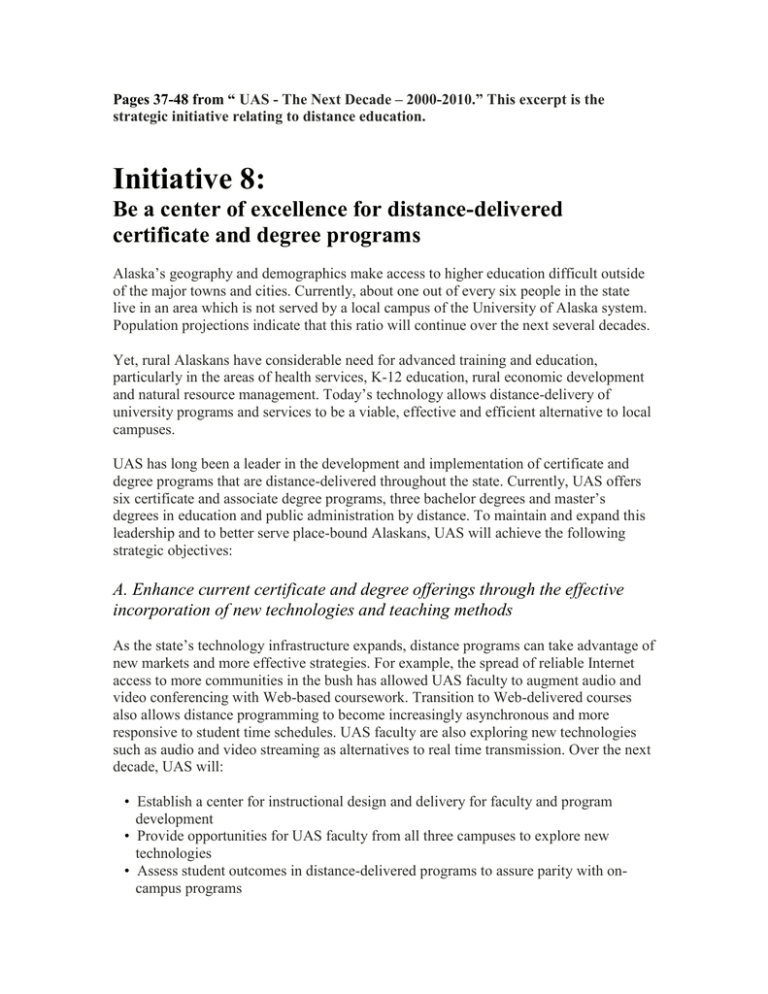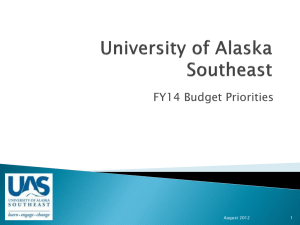UAS Strategic Plan, Initiative 8
advertisement

Pages 37-48 from “ UAS - The Next Decade – 2000-2010.” This excerpt is the strategic initiative relating to distance education. Initiative 8: Be a center of excellence for distance-delivered certificate and degree programs Alaska’s geography and demographics make access to higher education difficult outside of the major towns and cities. Currently, about one out of every six people in the state live in an area which is not served by a local campus of the University of Alaska system. Population projections indicate that this ratio will continue over the next several decades. Yet, rural Alaskans have considerable need for advanced training and education, particularly in the areas of health services, K-12 education, rural economic development and natural resource management. Today’s technology allows distance-delivery of university programs and services to be a viable, effective and efficient alternative to local campuses. UAS has long been a leader in the development and implementation of certificate and degree programs that are distance-delivered throughout the state. Currently, UAS offers six certificate and associate degree programs, three bachelor degrees and master’s degrees in education and public administration by distance. To maintain and expand this leadership and to better serve place-bound Alaskans, UAS will achieve the following strategic objectives: A. Enhance current certificate and degree offerings through the effective incorporation of new technologies and teaching methods As the state’s technology infrastructure expands, distance programs can take advantage of new markets and more effective strategies. For example, the spread of reliable Internet access to more communities in the bush has allowed UAS faculty to augment audio and video conferencing with Web-based coursework. Transition to Web-delivered courses also allows distance programming to become increasingly asynchronous and more responsive to student time schedules. UAS faculty are also exploring new technologies such as audio and video streaming as alternatives to real time transmission. Over the next decade, UAS will: • Establish a center for instructional design and delivery for faculty and program development • Provide opportunities for UAS faculty from all three campuses to explore new technologies • Assess student outcomes in distance-delivered programs to assure parity with oncampus programs B. Develop additional distance program offerings as demand warrants Over the past decade, UAS has expanded its distance offerings from its early work with the associate of arts degree through bachelor and master’s degrees. In addition, it pioneered work in distance technical degrees, such as the associate of applied science in Health Information Management and in Environmental Technology. In each new program, UAS responded to a demonstrated demand on the part of state citizens, business and industry. As the economy of the state and the aspiration of Alaskans change, demands for new programs will emerge. To anticipate and respond to these new demands, UAS will: • Seek information from campus councils, alumni and others • Scan regional and state employment trends to identify potential training needs • Work with other University of Alaska campuses to share resources for new program development and delivery • Partner with Lower 48 educational institutions to deliver specialized programs which are beyond the scope and means of the UA system C. Develop and initiate a comprehensive system of support services for distance students Distance students require substantial support if they are to be successful in meeting their educational objectives. Tasks such as enrolling for courses, purchasing books and accessing library materials—all of which are relatively simple on campus—can be very difficult at a distance. More complex services, such as financial aid, academic advising and tutoring assistance are even more problematic. But unless the university can provide these services in a stable and effective manner, the goal of universal access to higher education cannot be achieved. Therefore, UAS will: • Develop and implement a “virtual university” of student academic support services that can be accessed by both distance and on-campus students • Assess distance student satisfaction with e-services
